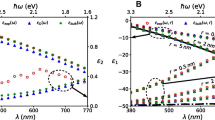Abstract
Yellow decorations in glasses have been produced since the beginning of the fourteenth century by incorporating metallic silver nanoparticles into the glass (from a few to some tens of nanometers). The optical response of the glass-particles composite is determined by the surface plasmon resonance absorption and scattering of the nanometric metallic particles. Generally, the same color is perceived in reflection and in transmission although dichroic effects are occasionally observed. As silver-stained glasses were designed to be observed in transmission, tuning the transmission color from yellow to red was of technological interest. The relationship between the color observed both in transmission and reflection and the composition and nanostructure of regular (yellow) and dichroic (yellow and red) silver stains from the Renaissance (late fifteenth and sixteenth century, respectively) is related to the presence of a layer (of about 10–20 μm thick) of metallic silver nanoparticles (from few to 100 nm in size). The correlation between the colors observed and the silver stain nanostructure is studied with particular emphasis on the origin of the dichroic behavior. The optical response is computed and compared to the experimental data. Differences in the synthesis parameters responsible for the colors and for the dichroic behavior of the silver stain glasses are proposed. This is essential for the replication of the glass pieces which are required as replacements in the restoration/conservation of the windows but is also of broader interest.






Similar content being viewed by others
References
Barber DJ, Freestone IC (1990) An investigation of the origin of the colour of the Lycurgus cup by analytical transmission electron microscopy. Archaeometry 32(1):33–45
Barley KC (1996) Tests et observations à propos de l’usage du jaune d’argent in: Grisailles, jaune d’argent, sanguine, émail et peinture à froid. Dossier de la Comission Royale des monuments, sites et fouilles, 3, Forum pour la Conservation et la Restauration des Vitraux, pp 117–121
Cable M, Smedley JW (1987) Liquidus temperatures and melting characteristics of some early container glasses. Glass Technol 28(2):94–98
Caen JMA (2010) The production of stained glass in the county of Flanders and the Duchy of Brabant from the XVth to the XVIIIth centuries: materials and techniques (Corpus Vitrearum, Belgium, Studies). Harvey Miller Publishers-Brepols, Washington
Colomban P (2009) The use of metal nanoparticles to produce yellow, red and iridescent color, from Bronze Age to present times in luster pottery and glass: solid state chemistry, spectroscopy and nanostructure. J Nano Res 8:109–132
Delgado J, Vilarigues M, Ruivo A, Corregidor V, Silva RC, Alves LC (2011) Characterisation of medieval yellow silver stained glass from Convento de Cristo in Tomar, Portugal. Nucl Instrum Method Phys Res B 269:2383–2388
Fluegel A (2007) Global model for calculating room-temperature glass density from the composition. J Am Ceram Soc 90(8):2622–2625
Gil C, Villegas MA (2004) Ruby coloured lead glasses by generation of silver nanoparticles. Mater Chem Phys 88:185–191
Gil C, Villegas MA, Fernandez-Navarro JM (2005) Preparation and study of superficially coloured lead glass. J Mater Sci 40:6201–6206
Greer AL (1999) Through a glass, lightly. Nature 402(6758):132–133
Heaton N (1947) The origin and use of silver stain. J Br Soc Master Glass Paint 10:9–16
Jembrih-Simbürger D, Neelmeijer C, Schalm O, Ferderickx P, Screiner M, de Vis K, Mader M, Schryvers D, Caen J (2002) The colour of stained glass- analytical investigations carried out with XRF, SEM-EDS, TEM and IBA. J Anal At Spectrom 17:321–328
Johnson PB, Christy RW (1975) Optical constants of noble metals. Phys Rev B 6(12):4370–4379
Kreibig U, Vollmer M (1995) Optical properties of metal cluster. Springer, Berlin
Lautier C, Sandron D (2008) Antoine de Pise. L’art du vitrail vers 1400. Edition CTHS, Paris
Magruder RH, Robinson SJ, Smith C, Meldrum A, Halabaica A, Haglund RF (2009) Dichroism in Ag nanoparticle composites with bimodal size distribution. J Appl Phys 105:024303-1–024303-5
Molera J, Bayés C, Roura P, Crespo D, Pradell T (2007) Key parameters in the production of medieval luster colors and shines. J Am Ceram Soc 90(7):2245–2254
Nobbs JH (1985) Kubelka–Munch theory and the prediction of the reflectance. Rev Prog Color 15:66–75
Perez-Villar S, Rubio J, Oteo JL (2008) Study of color and structural changes in silver painted medieval glasses. J Non-Cryst Solids 354:1833–1844
Pradell T, Molera J, Roque J, Vendrell-Saz M, Smith AD, Pantos E, Crespo D (2005) Ionic-exchange mechanism in the formation of medieval luster decoration. J Am Ceram Soc 88(5):1281–1289
Pradell T, Pavlov RS, Gutiérrez PC, Climent-Font A, Molera J (2012) Composition, nanostructure, and optical properties of silver and silver/copper lusters. J Appl Phys 112:054307-1–054307-10
Priven AI, Mazurin OV (2003) Comparison of methods used for the calculation of density, refractive index and thermal expansion of oxide glasses. Glass Technol 44(4):156–166
Quinten M, Kreibig U (1993) Absorption and elastic scattering of light by particle aggregates. Appl Optics 32(30):6173–6183
van de Hulst HC (1980a) Multiple light scattering; tables, formula and applications, vol 1. Academic Press, New York
van de Hulst HC (1980b) Multiple light scattering; tables, formula and applications, vol 2. Academic Press, New York
van de Hulst HC (1981) Light scattering by small particles. Dover Publications, Inc, New York
Verità M (1996) Composition, structure et mechanism de deterioration des grisailles in: Grisailles, jaune d’argent, sanguine, émail et peinture à froid. Dossier de la Comission Royale des monuments, sites et fouilles, 3, Forum pour la Conservation et la Restauration des Vitraux, pp 117–121
Acknowledgments
The project is funded by CICYT grant MAT2010-20129-C02 and Generalitat de Catalunya grants 2009SGR01225 and 2009SGR01251. Vetraria Muñoz de Pablos S.L. is thanked for providing the glass pieces studied, Chaoren Liu for his help with DSC measurements and Trifon Trifonov for his skilled help with the TEM sample preparation.
Author information
Authors and Affiliations
Corresponding author
Rights and permissions
About this article
Cite this article
Molina, G., Murcia, S., Molera, J. et al. Color and dichroism of silver-stained glasses. J Nanopart Res 15, 1932 (2013). https://doi.org/10.1007/s11051-013-1932-7
Received:
Accepted:
Published:
DOI: https://doi.org/10.1007/s11051-013-1932-7




